
My BIG SIX Tips for Big Rig Driving Success
My BIG SIX Tips for Big Rig Driving Success
Being behind the wheel of a large Class A isn’t as challenging as you may expect!
By: Don Cohen
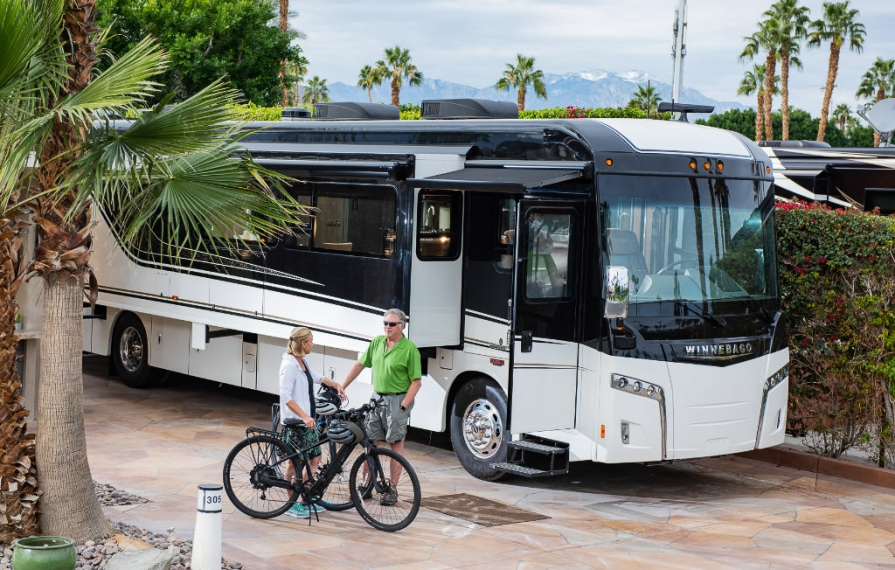
The early afternoon sun was soaking through the cottonwoods on a fifty-mile-per-hour, right-hand curve west of Helena, MT. A muffled pop announced that the front left tire had exploded, followed by the repeated slap against my fingers of the bucking steering wheel feeling like a clothes-pinned baseball card fluttering across bike spokes. My father, in the passenger seat, eyes wide, wordless, was looking half out the front windshield and half at me. Lurch left. Lurch right. Slow down. Move toward the grassy shoulder. Stop.
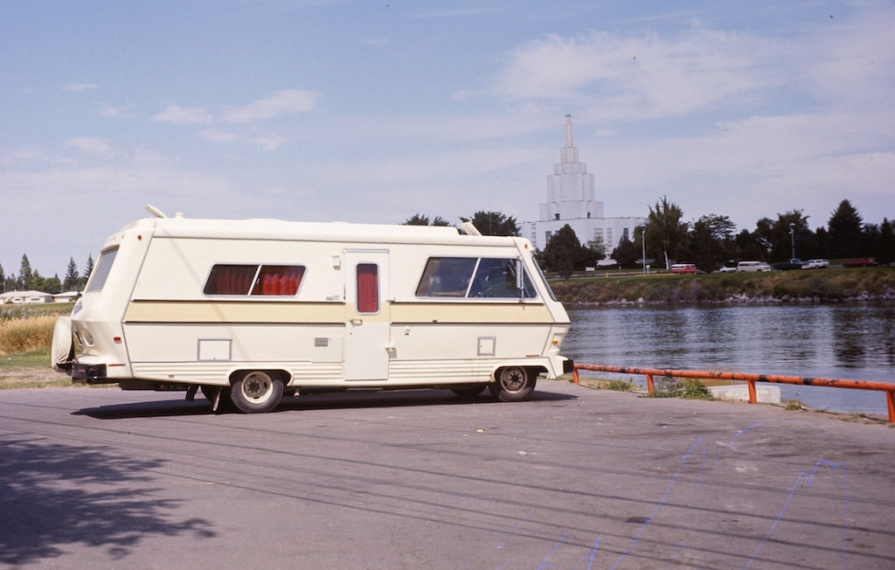
In 1971, this 25' Cabana rental motorhome was considered to be pretty large. Pictured here in Idaho Falls (with all the tires inflated).
It was the summer of 1971 and that was my first RV driving experience. I was seventeen, had just graduated high school and, with no summer plans before college, found myself on the road with my parents in a rental RV. It was a test to see if this might be a good way for my dad, a manufacturer's rep of dresses, to travel and work his Rocky Mountain territory. Despite my parent's soon-to-be-kindled love of RVing, a romance that would last for more than 20 years and 200,000 miles, this earlier experience did not endear me to the lifestyle.
Four decades later, when the RV itch unexpectedly muscled to the surface, a Sprinter-based Navion seemed more manageable size-wise, but on the first drive home from the dealer, even its comparatively petite size felt intimidating.
Now, with two years and 10,000 miles of big rig travel (on top of 90,000 Navion miles) I find myself surprisingly relaxed rolling around the countryside like a vehicular version of the Incredible Hulk. Driving a big rig is no doubt intimidating -- especially if you think about it from the outside in. But from an inside-out perspective, it's actually much, much easier than you might think. Frankly, I've surprised myself. (Read more about my initial thoughts on big rig driving).
So, here are my BIG SIX tips for Class A driving success. And while some of my thoughts are specific to diesel pushers, there's plenty of food for thought for any RVer to dine on.
1. Focus on Position of the Coach
As auto drivers, we are all taught both the principles and techniques of defensive driving. The toughest habit reset about big rig driving is that you are too big and slow to react as quickly as you can in a car. However, the reverse of that is you are so big, drivers are going to adjust around you.
Though I scan my side mirrors constantly, once I stopped worrying about what the cars next to me might do - and accepted the thought that my sole responsibility is to keep my rig in the lane - the driving experience became a lot more relaxing.
I feel it's my job to provide all the other drivers around me with a sense of predictability. That means they can trust that I will stay within my lane, brake gently, and signal in plenty of time before changing lanes or turning. What I've found is that invariably, be it through courtesy or intimidation, other drivers almost always adjust around me.
Because you sit up so marvelously high in a big rig, I find that it's easy to align the coach by tracking slightly to the right of the center line or a multi-lane line. This just-to-the-right-of-the-lane-line guidance generally centers my seat with the darker wear spot (or even shallow rut) of the roadway.
There have been a few occasions that lane and road conditions made me nervous enough to spill over into a second lane. On those occasions, and it's usually for a short stretch of a block or two of a city street, or a mile through a cone zone, I've had to tell myself my primary objective is to avoid wrecking the motorhome, and if other drivers are judging me harshly for being a road hog, it's not for me to please them, but to make sure that I get to where I need to be in one piece. They'll forget about me as soon as I disappear in their rear-view mirror.
Beyond width, there's also height. My general rule of thumb is, if a semi fits, so can I. I'm very mindful of staying on roads designed for big vehicles and really have never worried about bridge or canopy clearance. However, in campgrounds and residential streets you should pay attention to tree overhang. If in doubt, get out of the coach or have your co-pilot eyeball the foliage.
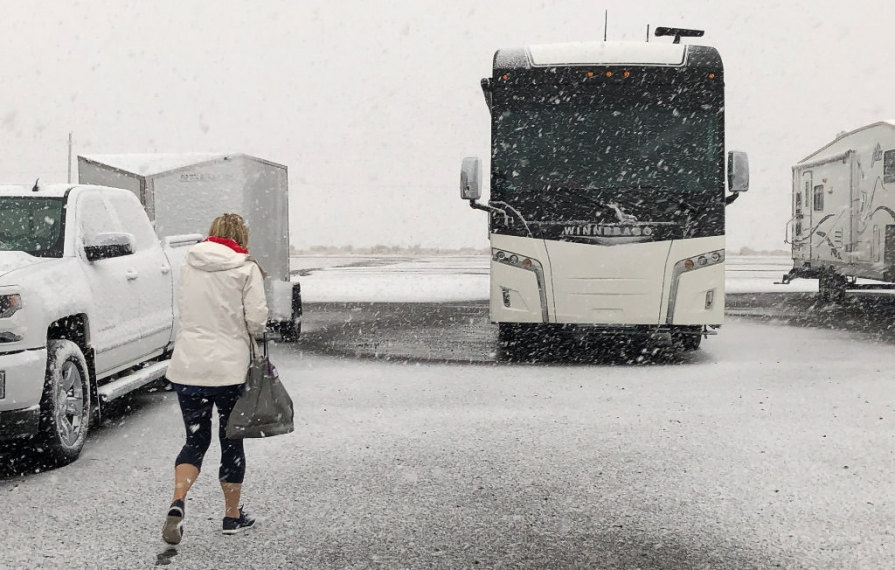
A late winter snow on the way to Salt Lake. With its weight, the Horizon drove confidently. Slower speed and good wipers are a must.
2. Use Your Mirrors
Big rigs have dual-side mirrors with both regular and wide-angle views. Take the time, while parked, to get your mirrors properly adjusted. I adjust my top (regular) mirrors so that they catch just a piece of the coach sidewall. For the wide-angle mirrors, it's good to have someone (who can help you adjust them) stand next to the side wall of the coach about six feet back to make sure they appear in the field of view. While many mirrors have motorized adjustment, you may need to loosen and re-tighten brackets for the gross adjustment and then fine tune with motor control.
The mirrors on our Horizon also have video cameras and when I flick the turn signal, the video on the big Xite screen switches to show that camera. I've found that the passenger side camera is more valuable for spotting cars snugged up alongside and it's also helpful for seeing cars merging onto the freeway. However, the more time I've spent driving the Horizon, the more I rely simply on the mirrors versus the video camera. Universal to driving any RV is breaking the habit of looking in the rear-view mirror. Once you get used to using your side mirrors, it quickly becomes second nature.
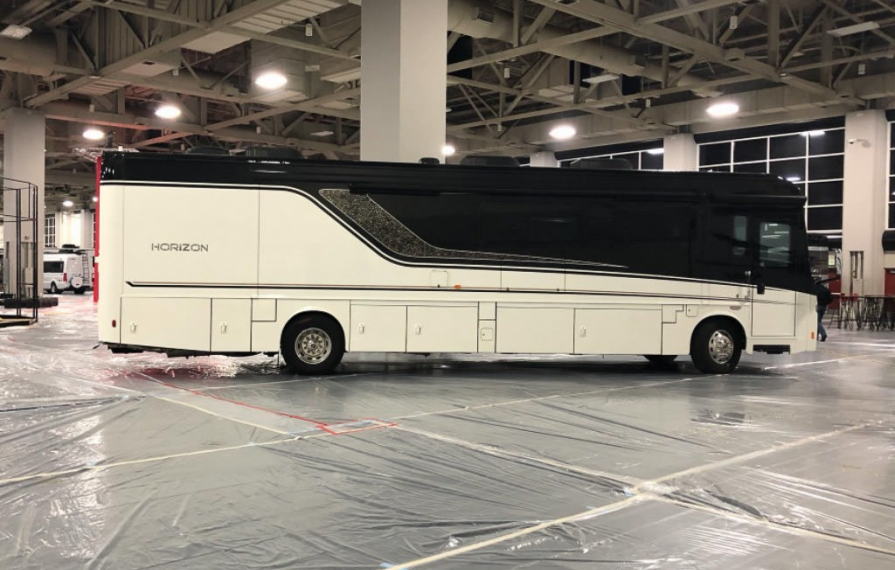
It turned out that driving into the Salt Palace Convention Center for the RVX Show was easier than pulling into many campground spaces.
3. Get Help When Backing Up
Video back up cameras are always helpful. I've happily embraced them in both our SUVs. However, with a big rig, I feel that while a video camera can get you in the ballpark, it's sure nice having a human outside giving directions.
Unlike a car, when you have a big rig, you have to be cognizant that, as you are turning to back into a space, your front might swing around into an obstruction (sign, fence, car ... you name it). When backing up a big rig, you absolutely need to think of both front and rear clearance.
I, like most RV drivers, prefer having someone guide me back by standing on the driver's side of the coach - so I can see them in my left mirror instead of turning my head to look across to the right. My wife and I have evolved to understand the language of hand signals and I've learned, especially with a big rig, if I'm being signaled to "cut right" that I need to turn the tires aggressively, not gently, as you might with a car.
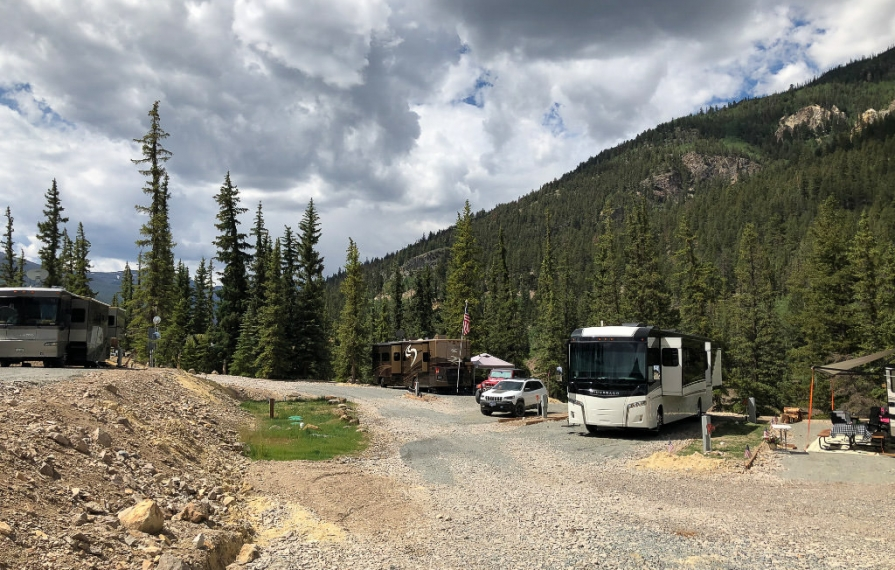
Perfectly parked in a hard-to-maneuver campground in Lake City, CO. This took two people (front and back) to act as spotters.
4. Swing Wide on Turns
Unlike cars or Class C RVs, a big rig positions the driver's seat almost directly above the front wheels. This gives you an unusually good view of the front of the rig. And here's an often-overlooked design feature of Winnebago Class A products -- the company works hard to design a strong passenger cage, but also manages to make the A pillars in front narrower than most of the competitors. What that means is better visibility for the driver.
I learned pretty quickly to swing wide on turns. If there is a double turn lane, I generally prefer being on the outside one. If, like us, you're towing a car, you need to be especially cognizant of taking a wide swing with as long an arc as possible, so your tow vehicle doesn't drift to the inside of the turn. For freeway ramps and urban streets, I haven't found any difficulties. However, in situations where you may be fueling in a non-truck stop kind of facility, you do need to think of your "exit" strategy pulling away from the pumps. On occasion, I've walked the direction I plan to exit from the pumps, looking at the tightness of curves, side obstructions, overhangs, and pavement potholes.
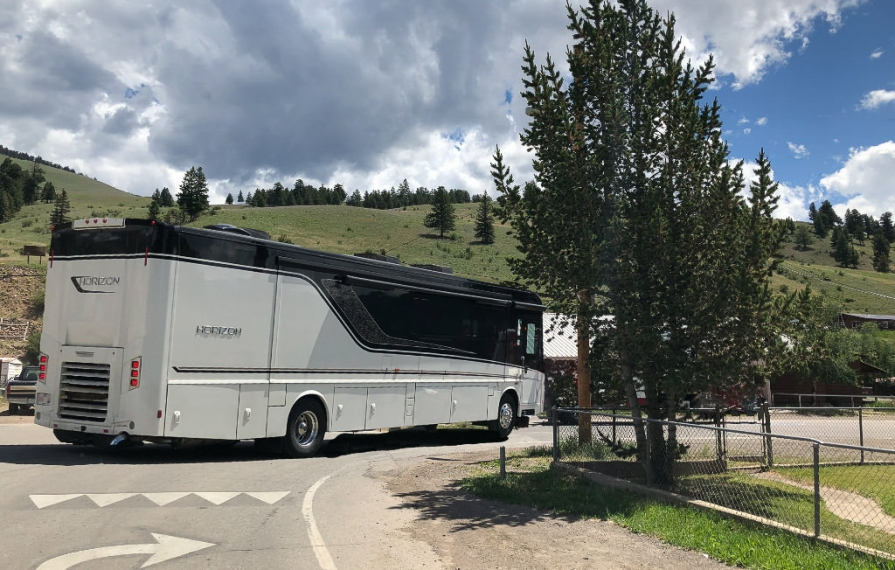
It's a tight right turn in Creede, CO, and required a brief wait to swing out into the oncoming lane after other cars had gone by.
5. Be Cautious and Prepared When Braking
All of the current Freightliner-based Winnebago diesel pusher models use a combination of an exhaust brake along with a computer-controlled, six-speed transmission. The exhaust brake is turned on by a rocker switch. It's really a set-and-forget kind of thing. Once on, whenever you take your foot off the accelerator, you will feel the engine start to brake. If you've ever driven an all-electric car, this phenomenon will feel familiar. Even on flat freeway stretches, I leave the exhaust brake on for slowing descent on modest grades or adding stronger deceleration if you're coming up on slowed traffic.
Growing up and living in Colorado, I've been driving high mountain passes since my dad taught me on my learner's permit fifty years ago. Back then, downshifting for engine braking was an important technique. Today, it's essentially the same, but even better with the combination of the exhaust brake and Allison transmission. Most highways will post a recommended speed for curves and grades. These recommendations are specifically for big vehicles, like trucks and RVs.
I have found that if I decelerate to the suggested speed, and maybe even five miles per hour slower, the engine braking and transmission shifting do a very good job of holding the rig back. I am super careful about not letting speed creep up. It also helps that I have an auxiliary braking unit (we use an RVi) tapping the brakes of our tow car as the coach is slowed.
On a few times, where I was getting a little impatient on descent and did let my speed creep up, I'd ride the brakes a little harder and start smelling the brake pads. You want to avoid that, and generally can, if you remain cautious and patient in your descent.
6. Keep Your Tow Vehicle in Mind
When we towed a car behind our Navion, I was always aware of its tug on the motorhome. In a diesel pusher, because of its power and weight, you have no sense that you have anything attached. Honestly, the first time I hooked our tow car to the Horizon I was worried about length and handling. Well, that fear was completely overblown. It's really a non-issue in terms of driving feel.
However, as I said earlier, I'm careful to keep the tow car in my rear view as I turn to make sure I don't clip anything. I'm also careful in thinking about the length of an area that I'm pulling off on to make sure it's long enough. As a matter of practice, we use the auxiliary screen with the Xite infotainment unit to continually display the rear camera where we can keep an eye on the car.
Finally, remember that you can't back up. In the last year and a half, I've found myself in three unplanned situations where we needed to unclip the tow car to get into a campground spot and, in one case, effect a tight turnaround of the coach based on a bad GPS direction.
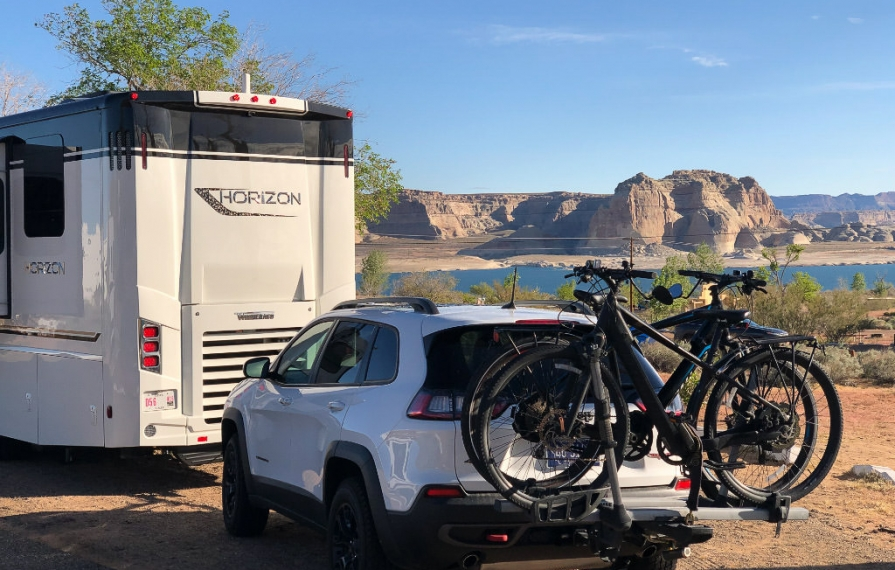
You may not feel your tow car there, but you're always keeping an eye on your mirrors and rear video camera, just for good measure.
If I can. You can.
Big rig driving isn't hard. Anyone can master driving a large coach. However, it can be very intimidating in the beginning. Somewhere in the guy manual' you're not supposed to admit to intimidation. But I will! And as I see more and more women hop down out of their semi cabs at truck stops, it affirms the fact that it certainly isn't a man's job' either.
Like just about anything else in life, your mind paints a much more threatening picture than the actual reality. When I first started driving a diesel pusher nearly two years ago, I would find myself worrying the night before about what challenges' I might encounter. I'd climb into the seat feeling a heightened sense of nervousness. I'd concentrate extra hard on switches, mirrors, dash display, and just about everything else around me. Within ten minutes of starting out and getting on the highway, I'd start to relax ... not completely ... but a little.
Fortunately, like any skill you practice, things become easier. Today, I hop into the seat just as comfortably as I do getting into a car. My mind works through a different checklist of switches and mirrors with the same habitual comfort of driving our cars. And what I've found is that driving a big rig isn't a chore, but it's actually fun. This is especially true with Winnebago's panoramic windows. Re-driving familiar routes like Monument Valley and the Colorado high country in the Horizon is like sitting in a lounge chair in an IMAX theater. It's awesome. And now, I'm relaxed enough to fully enjoy it.
Comments
Comments on this post are moderated, so they will not appear instantly. All relevant questions and helpful notes are welcome! If you have a service inquiry or question related to your RV, please reach out to the customer care team directly using the phone numbers or contact form on this page .